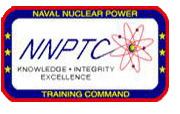Administrative staff 500 | Students 2,500 | |
 | ||
Motto Knowledge, Integrity, Excellence Established 1993; 24 years ago (1993) Commanding Officer Captain Kevin Byrne, USN | ||
The Naval Nuclear Power Training Command (NNPTC) is the parent organization within the United States Navy's Naval Education and Training Command that is responsible for educating enlisted and commissioned personnel of the US nuclear naval program. NNPTC's mission is to train officer and enlisted students in science and engineering fundamental to the design, operation, and maintenance of naval nuclear propulsion plants. NNPTC houses Nuclear Field "A" School and Naval Nuclear Power School. These two schools were formerly independent entities run by separate commanding officers and structures. NNPTC was created in 1993 to streamline the command structures of both schools, with each school ultimately reporting to a single commanding officer of NNPTC.
Contents
History of locations and commanding officers
NNPTC was originally created when the two schools were located at the former Naval Training Center Orlando (Florida). The NNPTC's first commanding officer was Captain Steven G. Slaton (USN Ret), who was the commanding officer of Nuclear Field "A" School when NNPTC was created in 1993. Captain Kevin Byrne is the commanding officer as of July 10, 2015.
When NNPTC graduated its final class in Orlando, in December 1998, the organization moved to Naval Weapons Station Charleston in Goose Creek, South Carolina, which is a suburban community of Charleston, South Carolina.
Map of current location
Controversies
NNPTC was noted for discharging 72 sailors under the "Don't ask, don't tell" policy in 2000, representing 23% of all such discharges for the Navy that year, and as a result drew national media attention. The subsequent year (2001), NNPTC lowered the number of gay discharges to 28.
In 2011, two male students were charged with a violation of UCMJ Article 92 for "willful failure to exhibit professional conduct", when the roommate of one of the sailors claimed to have witnessed them sleeping together, while the two claimed to have fallen asleep watching a movie. The facts were insufficient to support a charge of homosexual conduct and so NNPTC opted to charge them with unprofessional conduct at non-judicial punishment (NJP). One of the sailors accepted punishment at NJP and received a suspended reduction in rank believing that the incident would go no further. The other, Stephen Jones, demanded courts-martial and through his attorney contacted national media outlets, revealing not only his name but the name of the sailor with whom he was accused to sleeping. As NJP is intended to be a private matter, several instructors approached the then-CMC{Command Master Chief} to attempt to keep the first sailor's name out of the press, but they were rebuffed by the command. Ultimately, the charges against Jones were dropped, though the sailor who accepted NJP kept the forfeiture of pay he had been awarded.
Time Capsule
In 1989, NNPTC buried a time capsule on their grounds. On September 22, 2014, it was dug up to reveal its contents: an old NNPTC command ball cap, a command name tape, multiple newspapers from that day, and other unidentified items.
